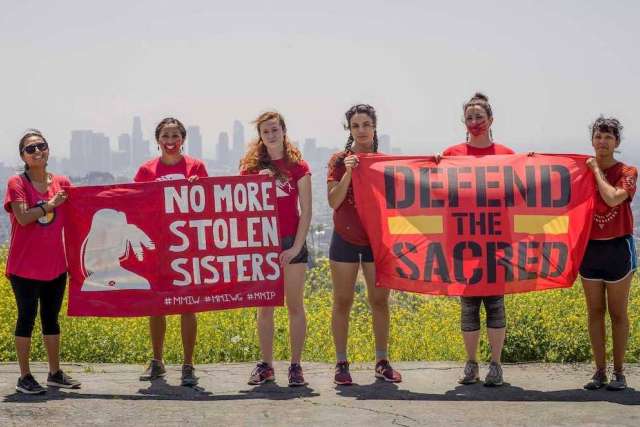In North America, the public has largely overlooked the epidemic of missing and murdered Indigenous people. From 2011 to 2020, 710 Indigenous people, mostly girls, have gone missing in Wyoming alone.
According to research, 84% of American Indian and Alaska Native women have experienced violence in their lifetime. They also face murder rates at almost three times that of non-Hispanic white women.
Jordan Marie Brings Three White Horses Daniel, a citizen of the Kul Wičasa Oyate, also known as the Lower Brule Sioux Tribe, is a professional runner and project manager at the UCLA Clinical and Translational Science Institute. She’s also a filmmaker, founder of the grassroots organization Rising Hearts and an advocate for Indigenous-related racial, social and economic issues and intersectional advocacy.
She is devoted to bringing attention to the issue of missing and murdered Indigenous women, which has been ongoing for centuries, she says.
“It’s something that's been happening every year of our existence,” Daniel says. Though it may be considered “unpopular” to acknowledge, Daniel says, the erasure has been happening since colonialists arrived on these lands.
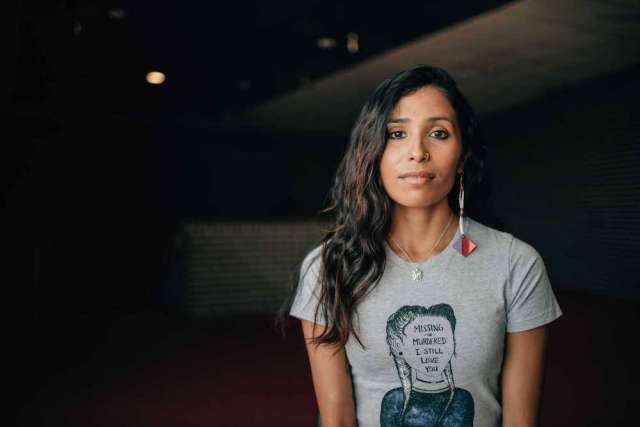
A history of unsolved cases
The movement to highlight the issue, Missing and Murdered Indigenous Women (MMIW), began in Canada, Daniel says. Since the late 1960s, dozens of people, most of them Indigenous, have gone missing or been murdered near Highway 16, a remote stretch of highway in British Columbia also known as the Highway of Tears.
Though a special unit formed by the Royal Canadian Mounted Police linked 18 cases to this highway, many believe the total is closer to 50. Nearly all cases remain unsolved.
The violence, Daniel says, is an element of the historical and systemic pattern of devaluing and erasing Indigenous people.
“The (government) system was set up in a way that whitewashes our history of Indigenous peoples and these lands,” she says, adding that the erasure has been perpetuated in mainstream media. “We saw it on CNN when they labeled us as ‘something else,’ regarding voting turnout, we saw it with Rick Santorum, again on CNN, and we see it continuously with the cultural appropriation of ‘Poca-hottie’ costumes.
"Different forms of violence have different impacts on health - they can have emotional impacts as well as physical impacts on the health and well-being of many."
Dr. Laura Kollar, U.S. Centers for Disease Control and Prevention
“And we just saw it again on Fox News when anchors discussed Indigenous Peoples Day while devaluing and saying ignorant remarks about Indigenous peoples on live television. We just saw it at a school in Riverside where a teacher dressed up as red face, wearing a headdress and continued to teach her math lessons with tomahawk chops and ignorant remarks, in front of students, but also Indigenous students in the classroom.”
Racism and stigma are components of the violence against Indigenous people, according to Laura Kollar, PhD, a behavioral scientist with the Division of Violence Prevention at the U.S. Centers for Disease Control and Prevention.
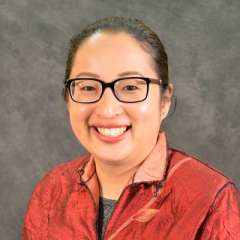
And ultimately, Dr. Kollar says, violence is a public health issue.
“Different forms of violence have different impacts on health – they can have emotional impacts as well as physical impacts on the health and well-being of many.”
According to 2018 data from the National Vital Statistics System, homicide was the sixth-leading cause of death among American Indian and Native American girls and women ages 1 to 44. Among men of the same age range, homicide was the 3rd leading cause of death.
Violence affects the health of people that are targeted, people who perpetrate violence and the communities in which both live, studies show. Systemic violence may result in depression, anxiety, substance abuse, chronic and infectious diseases and death.
Raising awareness
Though the advocacy work is often maddening and exhausting, Daniel says, it is essential to who she is.
“It's just been something that has always been part of my life even before I knew what the hashtag (MMIW) was,” she says.
“In 2006, going into my freshman year of college, I was in South Dakota visiting family before I started my first year of college. My mom was part of a search and rescue party to find Victoria Eagleman. And sadly, she was found murdered a month later. Her mother, June Left Hand, still fights for justice to this day.”
In reflecting on the funerals of women from her community that she had attended throughout her life, Daniel says she realized many of the deaths were likely the result of domestic violence.
“It’s really heartbreaking to see this and how deeply rooted it is within our community and families,” she says.
In 2017, Daniel was moved by the horrifying murder of Savanna LaFontaine-GreyWind of the Spirit Lake Nation – a pregnant woman from Fargo, N.D., whose child was cut from her womb and kidnapped. Daniel organized a prayer vigil for LaFontaine-GreyWind in the Washington, D.C. area, and began to use her blog and platform to help bring more attention to MMIW.
"I was tired of seeing the missing-people fliers, families speaking out on Facebook and Instagram, sharing how hard it has been,"
Jordan Marie Brings Three White Horses Daniel
“I saw this injustice happening and the lack of visibility of this issue in the media and in the data, and just did everything I could,” she says. The same year, former North Dakota Sen. Heidi Heitkamp introduced a bill called Savanna’s Act, requiring the Department of Justice to develop protocols and data collection to address cases of murdered or missing Native Americans.
Daniel moved to Los Angeles later in 2017 and began organizing rallies and panels to further amplify awareness of MMIW. She began to dedicate her runs, including the 2018 San Diego half-marathon, to missing and murdered Indigenous women and their relatives. Initially, the #MMIW hashtag drew little attention.
“I was really frustrated and losing hope in humanity,” Daniel says. “I was tired of seeing the missing-people fliers, families speaking out on Facebook and Instagram, sharing how hard it has been and the racism they’ve experienced with law enforcement and how the judicial system is failing them.”
Her emotions crested during a trip to Boston with Wings of America, a development program that, among other activities, sent five Native youth for college visits in 2020. Their chaperones would run the Boston Marathon to raise funds.
“I chose to use that marathon and run in prayer,” she says. “I asked my mom to get me red paint and I had no idea what I was going to do with it until I was sitting in the car with my partner and he was driving me to the starting line. I just let my fingers do the work.”
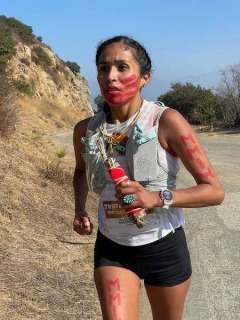
Daniel painted “MMIW” along her leg and arm. She used the red handprint across her mouth, which symbolizes the silencing of Indigenous voices by violence.
“I remember thinking, ‘I'm probably going to stick out like a sore thumb and people are going to be staring, but I don't care,’” she says. “This run is no longer about me. It's not about my ambition or anything like that. It's about just getting to the finish line and honoring them for every single mile.”
All eyes were on Daniel this time. The image of her with the red handprint across her face went viral. She was featured in Sports Illustrated, Runner’s World and on the covers of three other magazine.
Speaking up for families
Publicly dedicating her runs to Indigenous people who have been murdered or gone missing has helped Jordan to make connections with their families. Now, she says, her advocacy includes providing resources to support the families of missing and murdered people, because “oftentimes the families are lost and forgotten within this whole process.”
More often than not, she says, families are left to lead search and rescue efforts, which causes stress and emotional pain.
“Some of them are struggling to stay afloat. Some of them are struggling with mental health issues and trauma and financial responsibilities.”
Grassroots organizations and donations have filled the gaps for many families but have not solved the root issues and inequalities.
Following a prayer run dedicated to Victoria Eagleman, her mother, June, reached out to Daniel. She shared with Daniel how the media portrayal of her daughter had left her bitter and with broken promises.
“I'm really glad that (June) has trusted me to help be a voice for Victoria and to help support their family in any way that I can,” Daniel says. “She got to the point where she didn’t want to talk about Victoria to anyone."
Now, Daniel says, June is raising her daughter’s five children. “We are trying to help her through fundraising, and find a home for her and her family.”
Violence and its health impacts
Mental, emotional, physical or social burdens that arise as the consequence of violence can have health effects across the lifespan, according to the CDC. Dr. Kollar points to a CDC resource called Connecting the Dots, which aims to understand how violence is interconnected and prevent it in all forms.
“When you're a survivor of one type of violence, that makes you more likely to be a victim of other types of violence. In thinking through shared risk and protective factors for multiple forms of violence, there are things that are specific protective factors to our Indigenous communities,” Dr. Kollar says.
To understand the overlapping factors and causes of violence, public health organizations categorize them into “shared risk and protective factors.” The CDC says strengthening protective factors can play a major role in diminishing and preventing violence. Examples include strong and stable connections to family, school, community, native languages and traditional practices or customs.
“There are very rich protective factors and strengths-based components (in Indigenous communities) that are important to lift up,” Dr. Kollar says. “I think that this is a really important piece.”
Additional policy efforts to address and prevent violence against Indigenous women are underway across Canada and the U.S. For example, in June 2021, the Canadian government released a plan to address as many as 4,000 missing and murdered Indigenous women and girls.
In 2019, the “Not Invisible Act,” sponsored by U.S. Department of the Interior Secretary Deb Haaland when she served in Congress, was signed. It created a commission to establish best practices to improve intergovernmental coordination and ensure Indigenous people don’t continue to go missing.
That same year, an executive order was signed to form a Task Force on Missing and Murdered American Indians and Alaska Natives. In 2020, Operation Lady Justice, the name of the task force, released its one-year report on activities and accomplishments during the prior year.
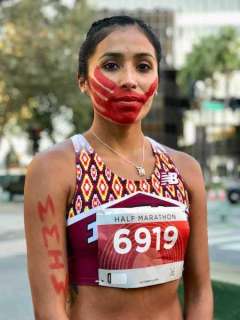
On May 7, 2021, Daniel participated in one of the Operation Lady Justice listening sessions. In her testimony, she shared that the heart of this work has been grassroots: “It is the families that are the ones pushing for justice and demanding accountability. They are the ones leading and organizing the search parties with community and sometimes, ally support. The families and advocates need to be part of these task forces, to help guide and inform, and be in the development of national led efforts.”
Continuing the work
Other UCLA faculty are involved in these efforts. Data for an Operation Lady Justice listening session in July 2021 was provided by Delight E. Satter, MPH, faculty associate at the UCLA Center for Health Policy Research and senior health scientist for the Office of Tribal Affairs and Strategic Alliances, Center for State Tribal, Local and Territorial Support, CDC.
Satter and Ninez A. Ponce, MPP, PhD, professor in the UCLA Fielding School of Public Health, along with others, co-authored a journal article about using a violence-prevention public health approach to address and prevent missing or murdered Indigenous persons.
In addition to public health knowledge, the article encourages Native knowledge and cultural practices be used to combat violence – similar to the protective factors Dr. Kollar discussed.
In her Operation Lady Justice testimony, Jordan pressed federal, state and local governments to “uphold their federal trust responsibility to Native nations.”
The laws passed “are literally going to save lives,” she said, “and be part of the new rebuilding of our future of all people that is safe and thriving. Not only for us today, but our next generations.”
The National Indigenous Women’s Resource Center, or MMIW Resource Guide, compiled by Lakota People’s Law Project, includes a hotline for Indigenous peoples experiencing violence, a guide to creating a safety plan and tools for helping friends or family members.
The Sovereign Bodies Institute advocates for legislation, provides reports and webinars, works with law enforcement to correct the data in the reports, holds their own database of missing and murdered Indigenous people and provides support and direct services to the families and survivors.
Learn more about the work of additional organizations and the resources available.
